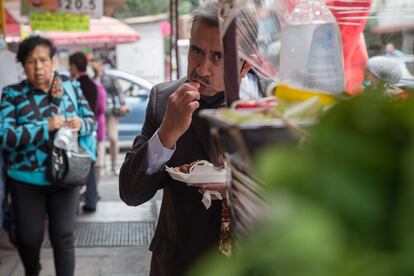Inflation jeopardizes Mexicans’ nutrition and health
As the cost of fresh produce skyrockets and outpaces general price hikes, prepared and processed foods are less expensive but not as healthful


The increase in the cost of basic food products is causing problems for families beyond the quantity of food they consume and the amount they pay for it. Higher prices also influence the quality of food they eat. These costs ultimately force the consumer to abandon the healthy habit of cooking at home in favor of buying and eating cheap but unhealthy street food or prepared meals from the supermarket. In a country that’s already afflicted by diseases like diabetes and hypertension, this is a worrisome development.
At his grocery store in Iztapalapa, Mexico, Reyes Barrón has noticed gradual changes in his clientele’s food consumption. “They come for 15 pesos of ham, they buy fewer eggs and, yes, they buy a lot of the famous Maruchan soups, although people say that they’re very bad,” he says. For her part, Lilia Rodríguez takes longer every day to decide what to buy at the market. Today, she’s purchasing some tomatoes, a couple of onions and a handful of árbol chiles to make rice, plus five eggs and a few slices of ham. She and her two daughters, ages 14 and 16, will have eggs with ham and rice as well as ten pesos worth of tortillas. “You want to give your family the best, but even the tortillas are expensive,” she says at her job in the Roma neighborhood. “Sometimes, it’s better to buy something already prepared; it’s faster,” she says.
Price increases are changing Mexican eating habits. While the cost of supplies such as fuel for cooking and transportation, as well as services, have risen, higher food prices have hit Mexicans the hardest. “First we eat what there is, and then we eat what we can afford,” explains Julieta Ponce Sánchez, the director of outreach at the Center for Food Guidance (Centro de Orientación Alimentaria, COA), in an interview. “Unlike other countries, in Mexico consumption is determined by accessibility.”
If they’re forced to choose between a kilo of potatoes, green tomatoes and oranges, some people prefer instant soup, a tamale (35 pesos at a street stall) or stew-filled tacos for about 40 pesos; these prepared meals also eliminate the hassle of cooking.
While generalized inflation reached 8.15% in July, its highest rate in 22 years, a look at the National Consumer Price Index shows that the price of fresh foods – the healthiest ones to eat – have increased most drastically. “We have a much harder time seeing what we call the ‘food landscape’ correctly: what you see is what you consume; when money’s tight, the brain [wants to] consume what it’s familiar with, [and] what you see most are the prepared, ultra-processed and less healthy products,” says Ponce.
For example, according to data as of July 2022 from the National Institute of Statistics and Geography (Inegi), products such as crackers, bread and flour have increased annually by 3.20%, meats by 3.40%, pastries and bulk products by 1.81% and, on average, food prepared outside the home has increased by 1.25%. In contrast, the price of fresh foods has gone up much more. In the last month alone, egg prices rose the most because of inflation, with a monthly increase of 8.31%; compared to June 2022, the cost of oranges climbed by 15.51%, onions by 13.79%, potatoes by 11.96% and green tomatoes by 20.41%.
The tortilla, the foundation of Mexican cuisine, is one of the foods that most affects the nutrients people consume through their daily meals. The staple food’s price has increased by an average of 13.52% through August of this year, the highest jump in the last five years. “There’s a tendency to consume less food, but heavier food that’s much higher in carbohydrates,” says Ponce. “When workers are coming from the subway or public transportation, they prefer to eat a tamale, something that has volume and fills them up,” Ponce adds.
These conditions have created the dangerous phenomenon of “pirate tortillas.” In videos on social media and interviews with the local press, Sergio Jarquin Muñoz, a manufacturer and the head of the Traditional Tortilla Governing Council (Consejo Rector de la Tortilla Tradicional), explains that tortilla makers use more lime, expired corn and non-potable water to reduce production costs. Jarquin Muñoz warns that this not only diminishes the tortilla’s nutritional value but also puts consumers’ health at risk.
“When you see a tortilla for less than 13 or 14 pesos, you have to be skeptical about that tortilla’s quality,” Jarquin Muñoz told UnoTv. The average price at the country’s tortilla shops is 21.24 pesos, according to the Ministry of Economy’s National Market Information and Integration System.

Pacic has not been enough
Reyes says that he’s concerned about the situation that Mexican households are facing. “They blame it on the pandemic, then the war, who are they going to blame tomorrow?” he wonders. At his grocery store, he often receives the aid cards that the government gives older adults through the Welfare Bank. “You can tell when they’re deposited, because [customers] buy a little more from me, and after that they can’t afford as much.”
President Andrés Manuel López Obrador’s Package against Inflation and Scarcity (Pacic; Paquete Contra la Inflación y la Carestía ) offered a strategy for producing, distributing and selling 24 basic food basket products. However, as of July, the program hasn’t significantly stemmed the increase in the prices of these items. Overall, food inflation went from 13.72% in April 2022, before Pacic was announced, to 15.22% in the first week of July.
For Lilia, the important thing is that she and her daughters have something to eat. “If God gives us food, anything works,” she says. But just eating anything can negatively impact Mexicans’ health. “After three months, you can see the consequences of not consuming enough vitamins and proteins, especially in children and older adults; it can be a very serious situation,” Ponce avers.
Tu suscripción se está usando en otro dispositivo
¿Quieres añadir otro usuario a tu suscripción?
Si continúas leyendo en este dispositivo, no se podrá leer en el otro.
FlechaTu suscripción se está usando en otro dispositivo y solo puedes acceder a EL PAÍS desde un dispositivo a la vez.
Si quieres compartir tu cuenta, cambia tu suscripción a la modalidad Premium, así podrás añadir otro usuario. Cada uno accederá con su propia cuenta de email, lo que os permitirá personalizar vuestra experiencia en EL PAÍS.
¿Tienes una suscripción de empresa? Accede aquí para contratar más cuentas.
En el caso de no saber quién está usando tu cuenta, te recomendamos cambiar tu contraseña aquí.
Si decides continuar compartiendo tu cuenta, este mensaje se mostrará en tu dispositivo y en el de la otra persona que está usando tu cuenta de forma indefinida, afectando a tu experiencia de lectura. Puedes consultar aquí los términos y condiciones de la suscripción digital.










































